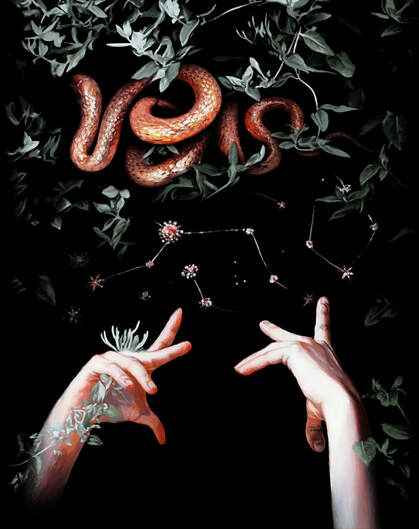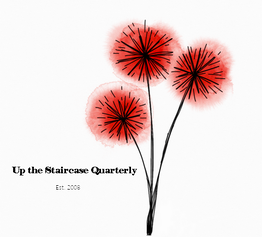Two poems by Jessica Q. Stark
Phylogenetics
There was a lonely cabin,
Within a dark, old wood,
And in it, with her mother,
There dwell Red Riding Hood.
When it began wasn’t clear, but isn’t it obvious that we always had a knack
for stories about little girls in danger?
Nice girls, stupid girls, naughty girls, girls bleeding and holding baskets of wine:
each knot another route to pity-blame the foal
Why not a hard-edge (for once) let the girl wander where she pleases
For the moral of the story isn’t always
the same, and how’s the one go where she doesn’t die alone and pretty
Where no Huntsman comes around to cut her out?
Who will answer for the anonymous limb, taking? Where once a wood, a
rice paddy. Where once a hole, a tooth.
Songs of the Buffalo Girl: wet strands in a basket housing
fingers that know their way around in the dark
Look now to Little Red Cap, taking all of her known objects to bed, taking
off her overcoat to reveal fine downy fur
Within a dark, old wood,
And in it, with her mother,
There dwell Red Riding Hood.
When it began wasn’t clear, but isn’t it obvious that we always had a knack
for stories about little girls in danger?
Nice girls, stupid girls, naughty girls, girls bleeding and holding baskets of wine:
each knot another route to pity-blame the foal
Why not a hard-edge (for once) let the girl wander where she pleases
For the moral of the story isn’t always
the same, and how’s the one go where she doesn’t die alone and pretty
Where no Huntsman comes around to cut her out?
Who will answer for the anonymous limb, taking? Where once a wood, a
rice paddy. Where once a hole, a tooth.
Songs of the Buffalo Girl: wet strands in a basket housing
fingers that know their way around in the dark
Look now to Little Red Cap, taking all of her known objects to bed, taking
off her overcoat to reveal fine downy fur
The Old Man in the Tree
Let’s begin before we are dead,
she sd, her first
memory was a
school wrapped in morning
darkness, a story about
walking girls and time
that passed too slowly
and inside that time, in purple
light and twigs at sun-up, sat an
old man she knew waiting
for her in a tree.
The first lesson
in fortitude against
invisible male members
everywhere and nowhere
is knowing one’s own
weight in wind and solitude
against the calculation of
memory’s dead leaves.
The rustling laughter, she wntd,
the hands like gnarled roots.
Passing by, you might mistake
a star for feeble eyes, arranging
stones and price tags in
exchange for departure.
It’s not cheap.
One morning in front of the
tree and the man of stars,
a white-cheeked monkey
bit her hard
and sat down to his meal
of fresh flesh
on a nearby fence
against a sky
slowly
breaking awake.
These days she still thumbs
the scar (forearm, right side)
when
she’s nervous around petty
men in positions of power.
Hidden manuals on how
to make a sacrifice of
the heart--a trivial thing
when you are so hungry.
She bartered early
one morning and
said it out loud.
And we do not speak
when we are dead,
they say we do not
speak when we are dead.
Sharp, dull bang against
the still, still night of
Vietnam, 1975, when her leaves
began quietly turning in onto
themselves,
undoing fairytales
and circumstance
And the corpses
were forgiven
their fantasies
And the tree was
cut into paper
And the TV sets were left out for good.
In the street: just quiet, like holding a
breath before the
quiet task of fate
And an old man somewhere high
was feeling satisfied with
his meal and his lodging and
he sang:
Buffalo Girls won’t you
come out tonight,
come out tonight,
come out tonight,
Oh, Buffalo Girls,
won’t you come
out tonight,
and dance by the
light of the moon?
she sd, her first
memory was a
school wrapped in morning
darkness, a story about
walking girls and time
that passed too slowly
and inside that time, in purple
light and twigs at sun-up, sat an
old man she knew waiting
for her in a tree.
The first lesson
in fortitude against
invisible male members
everywhere and nowhere
is knowing one’s own
weight in wind and solitude
against the calculation of
memory’s dead leaves.
The rustling laughter, she wntd,
the hands like gnarled roots.
Passing by, you might mistake
a star for feeble eyes, arranging
stones and price tags in
exchange for departure.
It’s not cheap.
One morning in front of the
tree and the man of stars,
a white-cheeked monkey
bit her hard
and sat down to his meal
of fresh flesh
on a nearby fence
against a sky
slowly
breaking awake.
These days she still thumbs
the scar (forearm, right side)
when
she’s nervous around petty
men in positions of power.
Hidden manuals on how
to make a sacrifice of
the heart--a trivial thing
when you are so hungry.
She bartered early
one morning and
said it out loud.
And we do not speak
when we are dead,
they say we do not
speak when we are dead.
Sharp, dull bang against
the still, still night of
Vietnam, 1975, when her leaves
began quietly turning in onto
themselves,
undoing fairytales
and circumstance
And the corpses
were forgiven
their fantasies
And the tree was
cut into paper
And the TV sets were left out for good.
In the street: just quiet, like holding a
breath before the
quiet task of fate
And an old man somewhere high
was feeling satisfied with
his meal and his lodging and
he sang:
Buffalo Girls won’t you
come out tonight,
come out tonight,
come out tonight,
Oh, Buffalo Girls,
won’t you come
out tonight,
and dance by the
light of the moon?
Jessica Q. Stark is a mixed-race, Vietnamese poet originally from California. She is a doctoral candidate in English at Duke University where she writes on the intersections of American poetry and comic books. She is the author of three poetry chapbooks, the latest titled Vasilisa the Wise (Ethel Zine Press, 2018). Her chapbook manuscript, The Liminal Parade, was selected by Dorothea Lasky for Heavy Feather's Double Take Poetry Prize in 2016. Her poems have appeared in Hobart, Tupelo Quarterly, Potluck, Glass Poetry Journal, and others. Her first full-length poetry collection, Savage Pageant, is forthcoming with Birds, LLC. She writes an ongoing poetry zine called INNANET. She is an Assistant Poetry Editor for AGNI.
Nam Das (Filipino, b. 1989) creates open-ended visual stories by arranging figurative elements into an assemblage forming a central idea, an idea that plays around Jungian archetypes of the collective unconscious or mythologems observed throughout history. He uses a limited palette of four colors in his oil paintings. Also called the Zorn palette, it's composed of: Titanium White, Cadmium Red, Yellow Ochre and Ivory Black. Nam began working as a full-time painter in 2019.

